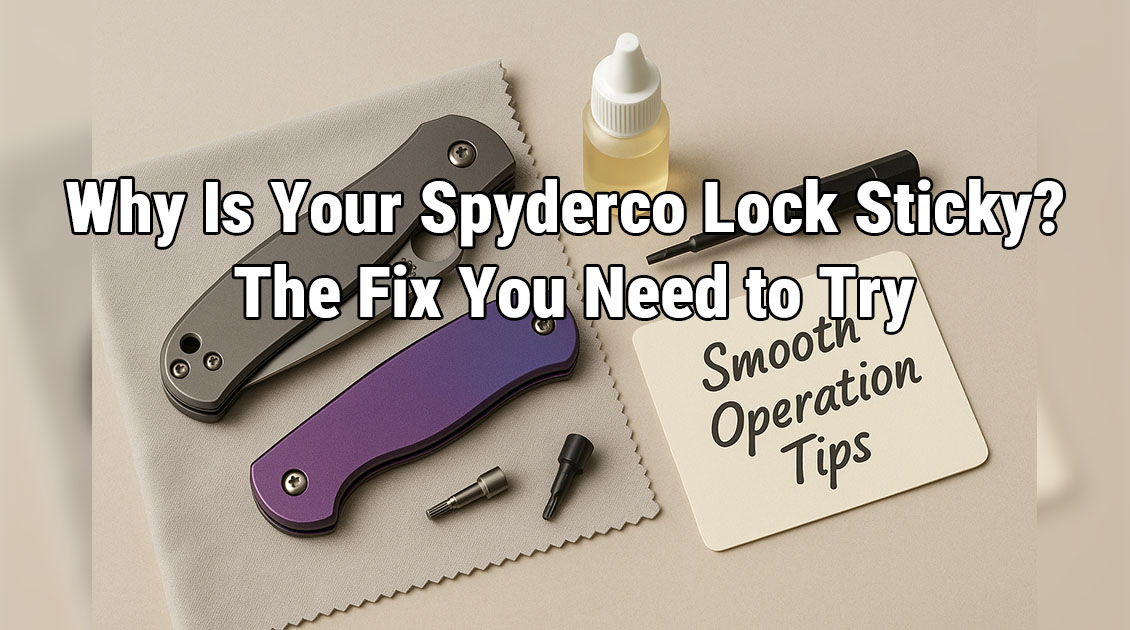Why Is Your Spyderco Lock Sticky? The Fix You Need to Try

This is the 28th blog of the Spyderco blog series. You can check the other blogs I wrote from here – https://spydercoparts.com/blogs
Author: Logan M. Fraser
Occupation: Custom Knife Modder & Spyderco Parts Specialist
Location: Based in Calgary, Alberta, Canada
If you’ve noticed your Spyderco lock getting sticky, especially on popular models like the PM2, Para 3, or Manix 2, you’re not alone—and you’re not stuck (pun intended). As a full-time knife modder and long-time Spyderco user, I’ve dealt with my fair share of sticky locks, gritty action, and lockbar tension issues. This blog walks you through why it happens and, more importantly, how to fix it using techniques and tools trusted in the knife modding community.
 What Does a Sticky Lock Mean?
What Does a Sticky Lock Mean?
A sticky lock usually refers to a liner lock or compression lock that grabs or drags when disengaging. You’ll often feel resistance, hear a “pop” as the lock breaks free, or even find the lockbar difficult to press. Over time, this can kill the fluid action Spyderco knives are known for.
Common Symptoms:
Lock won’t disengage smoothly
Clicking or popping sound when closing
Requires extra force to unlock
Blade sticks closed or open briefly
 What’s Causing It? Let’s Break It Down
What’s Causing It? Let’s Break It Down
There are several reasons why your Spyderco lock might feel sticky:
1. Factory Tolerances & Break-In Period
New knives often have tight lock interfaces. Give them a bit of time and they usually smooth out. That said, some locks never self-correct.
2. Overly Polished or Too Rough Lock Faces
A lock face that’s either too polished or too gritty can result in stickiness. This is common when someone tries to “tune” their lock and ends up doing more harm than good.
3. Dirty or Unlubricated Lock Interfaces
Grime or lack of lubrication can increase friction where the blade tang meets the lock face.
4. Lock Geometry and Lockbar Tension
Spyderco’s compression locks have a unique geometry that requires just the right amount of tension. If the lockbar is bent too much or not enough, you’ll feel it.
 How to Fix a Sticky Spyderco Lock
How to Fix a Sticky Spyderco Lock
Here are field-tested fixes that I’ve used on dozens of knives in my shop.
Step 1: Clean the Lock Interface
Use a Q-tip and 91% or higher isopropyl alcohol to clean where the lock meets the tang. Grit or leftover machining oil can make things sticky.
Useful Tip: Don’t forget to flush out the pivot area too. A gummed-up pivot will amplify lock stick.
Step 2: Apply the Right Lube
I’ve had excellent results using a drop of KPL Heavy or Nano-Oil 10W at the lock interface. These lubricants reduce friction without affecting lock strength.
Nano-Oil 10W: https://www.stclaircutlery.com/nano-oil

Step 3: Burnish the Lock Face
This method involves gently rubbing the tang and lock face together to help them “marry” better. Open and close the knife about 100 times. This will start to polish the contact areas just right.
Step 4: Sharpening Pencil Trick
Graphite acts as a dry lube. Use a pencil to color the lock face and the tang where they meet. Open and close a few dozen times. This can fix mild lock stick without tools.
Step 5: Address Lockbar Tension (Advanced)
If you’ve tried everything and the knife is still sticky, you might need to adjust lockbar tension. This is NOT for beginners.
How to Do It (Carefully):
Disassemble the knife
Use padded pliers to gently tweak the lockbar
Bend slightly inward for more tension, outward for less
If you’re not experienced with this, skip it or consult a modder.
 Compression Locks vs. Liner Locks: Which Is Worse for Stickiness?
Compression Locks vs. Liner Locks: Which Is Worse for Stickiness?
From my bench experience, compression locks like on the PM2 are more prone to stick because of the vertical lock engagement. Liner locks are generally more forgiving but can still stick if the surfaces aren’t properly tuned.
For those curious about the geometry, check out this detailed discussion from BladeForums: https://www.bladeforums.com/threads/why-does-my-lock-stick.1709244/
 Tools That Make the Job Easier
Tools That Make the Job Easier
Here are a few tools I always keep in my Spyderco repair station:
Torx drivers (Wiha preferred): https://www.wihatools.com/
KPL lubricant: https://knifepivotlube.com/
Nano-Oil: https://www.stclaircutlery.com/nano-oil
Microfiber cloth
Isopropyl alcohol 91%+
 Final Tip: Some Knives Just Need a Pro Touch
Final Tip: Some Knives Just Need a Pro Touch
If your knife still misbehaves after all this, you might have an issue with lock geometry or machining that only a pro can fix. I offer lock tuning services and custom upgrades through SpydercoParts.com, but even if you DIY, you now have a strong foundation.
 Goal Recap: What You Should Walk Away With
Goal Recap: What You Should Walk Away With
Understanding why lock stick happens
The exact steps to fix it
Tools and products that work
When to stop and call a pro
 Want a Better Lock Feel? Consider Upgrading Parts
Want a Better Lock Feel? Consider Upgrading Parts
Some aftermarket parts like upgraded bushings or bronze washers can make your lock smoother and more reliable. You’ll find compatible parts for the PM2, Para 3, and other models at https://spydercoparts.com. Each listing clearly shows model compatibility.
These aren’t gimmicks—they’re parts I personally use and install on customer knives across North America.
 What Do You Want to Learn Next?
What Do You Want to Learn Next?
Got a question about lock geometry, blade regrinds, or cleaning tips? Drop it in the comment section below. I’d love to hear what you’d like me to cover in next week’s blog!

